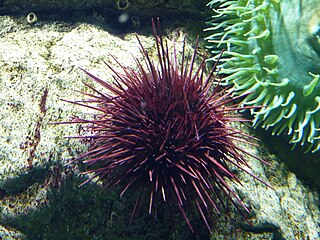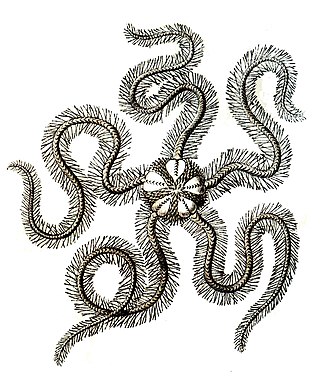
Sea urchins are spiny, globular echinoderms in the class Echinoidea. About 950 species of sea urchin live on the seabed of every ocean and inhabit every depth zone from the intertidal seashore down to 5,000 meters. The spherical, hard shells (tests) of sea urchins are round and covered in spines. Most urchin spines range in length from 3 to 10 cm, with outliers such as the black sea urchin possessing spines as long as 30 cm (12 in). Sea urchins move slowly, crawling with tube feet, and also propel themselves with their spines. Although algae are the primary diet, sea urchins also eat slow-moving (sessile) animals. Predators that eat sea urchins include a wide variety of fish, starfish, crabs, marine mammals, and humans.

Meoma ventricosa, known by the common names cake urchin and red heart urchin, is a large species of sea urchin which lives in shallow waters in the Caribbean. It may reach a diameter of twenty centimeters and is covered in reddish-brown spines. It has both pentagonal radial symmetry and bilateral symmetry, giving it a sand-dollar appearance; however, two of its five sections are merged more closely than the others.

Astropyga radiata, the red urchin, fire urchin, false fire urchin or blue-spotted urchin, is a species of sea urchin in the family Diadematidae. It is a large species with long spines and is found in the tropical Indo-Pacific region. It was first described in 1778 by the German naturalist Nathaniel Gottfried Leske.

Dendraster excentricus, also known as the eccentric sand dollar, sea-cake, biscuit-urchin, western sand dollar, or Pacific sand dollar, is a species of sand dollar in the family Dendrasteridae. It is a flattened, burrowing sea urchin found in the north-eastern Pacific Ocean from Alaska to Baja California.

The Parechinidae are a family of sea urchins in the class Echinoidea.

Psychocidaridae is a family of sea urchins in the order Cidaroida. The genus Psychocidaris is extant while the other genera are only known from fossils. The family has been in existence since the Lower Jurassic (Toarcian) and the range includes Europe, Ukraine, North America, North Africa and the West Pacific.

Echinidae is a family of sea urchins in the order Echinoida. Members of the family are found in the Atlantic Ocean and the Antarctic.

Lovenia is a genus of sea urchin that is the sister taxon to Berynia and Echinocardium.

Sterechinus is a genus of sea urchins in the family Echinidae. All living members of the genus are found in the waters around Antarctica but the first species described in the genus was a fossil and was found in Europe.

Sclerodactyla briareus, commonly known as the hairy sea cucumber, is a species of marine invertebrate in the family Sclerodactylidae. It is found in shallow waters in the western Atlantic Ocean.
Aspidodiadema jacobyi is a small sea urchin in the family Aspidodiadematidae. It lives in tropical seas at great depths. Aspidodiadema jacobyi was first scientifically described in 1880 by Alexander Emanuel Agassiz, an American scientist.

Heterocentrotus is a genus of slate pencil urchins, part of the familia Echinometridae. They are mainly found in the Indo-Pacific basin, especially in Reunion or Hawaii. This genus appeared in the Miocene and spread throughout the warm Indo-Pacific.
Lytechinus williamsi, the jewel urchin, is a sea urchin in the family Toxopneustidae. It occurs on shallow reefs off the coasts of Panama, Belize, the Florida Keys and Jamaica.
Pelanechinus is an extinct genus of sea urchins in the order Echinothurioida. It is placed in the family Pelanechinidae and is in the stem group of echinoids.

Ossicles are small calcareous elements embedded in the dermis of the body wall of echinoderms. They form part of the endoskeleton and provide rigidity and protection. They are found in different forms and arrangements in sea urchins, starfish, brittle stars, sea cucumbers, and crinoids. The ossicles and spines are the only parts of the animal likely to be fossilized after an echinoderm dies.

Diadema savignyi is a species of long-spined sea urchin belonging to the family Diadematidae. Common names include long-spined sea urchin, black longspine urchin and the banded diadem. It is native to the east coast of Africa, the Red Sea, the Indian Ocean and western Pacific Ocean. It was first described in 1829 by the French naturalist Jean Victoire Audouin. The specific epithet honours the French zoologist Marie Jules César Savigny who described many new marine species from the Mediterranean Sea and Red Sea. The type locality is Mauritius.

Gracilechinus is a genus of sea urchins in the family Echinidae.

Leodia sexiesperforata, commonly known as the six-holed keyhole urchin, is a species of sand dollar, in the echinoderm order Clypeasteroida. It is native to tropical and sub-tropical parts of the western Atlantic Ocean where it buries itself in soft sediment in shallow seas.

Flexibilia is a superorder of specialized Paleozoic crinoids. They exhibited a conserved body plan and consistent suite of characteristics throughout their long history. Previously considered a subclass with unclear affinities, later investigation determined that flexibles are well-nested within Cladida, a broad group ancestral to living articulate crinoids. The Ordovician cladid Cupulocrinus acts as an intermediate form linking the generalized anatomy of other early cladids with the distinctive anatomy of flexibles, and several studies have considered it to be ancestral to the rest of the group. Although flexibles never reached the same abundance or diversity as many other crinoid groups, they remained a reliable component of crinoid faunas, particularly from the Silurian onwards. Flexible fossils are very rare in the Ordovician, but the Late Ordovician appears to have been an interval of rapid diversification for the group.

















